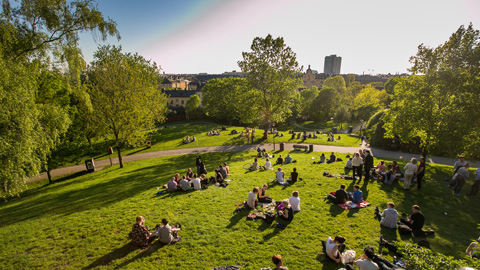Green urban planning must consider social equity criteria

01/06/2018
In recent years, public institutions have promoted greening initiatives in cities, recovering and creating green spaces and infrastructures with the aim of making them more liveable, more socially cohesive and healthier. However, researchers are now asking who can truly benefit from and enjoy these green spaces. The approval of the New Urban Agenda at the 2016 Habitat III conference in Quito, Ecuador, will make this greening trend to continue to intensify and diversify in the upcoming years. Therefore, researchers deem it necessary to analyse its social impact in a broad and systematic manner, especially among the most disadvantaged groups, so that these new environmental goods do not become green privileges for only a few.
These results, which are collected in the book Green Trajectories: Municipal policy trends and strategies for greening in Europe, Canada and the United States (1990-2016), published recently by the Barcelona Lab for Environmental Justice and Sustainability (BCNUEJ) in collaboration with the network of cities ICLEI-Local Governments for Sustainability, is one of the first products of a larger international European Research Council (ERC-funded study called GreenLULUs that seeks to determine the extent to which green cities in Europe, Canada, and the US are also racially and socially equitable. According to James Connolly, "as the green wave floods the cities, this book aims to take a step back and take stock of the effects".
The analysis indicates that the majority of the selected cities, all of them from Europe, Canada and the US, carried out ecological actions with the purpose of improving the physical and mental health of their inhabitants, revitalizing neighbourhoods and city centres, redeveloping post-industrial landscapes, minimizing the possible impacts of climate change, preserving nature and restoring their ecosystems. These actions consisted in the construction and rehabilitation of green areas, parks and ecological corridors, and the creation of permeable pavements or rain gardens. However, the study reveals that this "greening" of cities is deeply intertwined with their economic development, and many municipalities establish a direct relationship between their green performance and their capacity to compete for new investments and local development resources.
"For many cities, this green urban strategy is necessary to differentiate themselves from other cities and helps them attract, among other assets, highly qualified service-industry workers for the new economic sectors they are hoping to promote," says Isabelle Anguelovski. This finding shows how greening is commodified in today’s municipal practice. Cities that show off their green "brand" and boast the most more about their greening achievements also tend to be the most unaffordable ones, especially for the most vulnerable groups.
There is also a process of "green gentrification" that takes place when lower-middle and lower class neighbourhood residents are displaced by new residents with higher purchasing power who arrive to these areas attracted by the proximity of new parks, gardens and more attractive housing options. As a result, rental and housing prices substantially increase so that low-income residents cannot cope with the prices and must move to less attractive neighbourhoods with a lower quality of life. This is happening in cities such as San Francisco, Zurich or Boston.
However, when cities, such as Nantes, place equity and affordability at the centre of urban green policies, the relationship between urban green branding and unaffordability disappears. Therefore, the authors of the book emphasize that it is necessary to account for equity, displacement and exclusion concerns over the long term and take seriously issues such as green gentrification when planning and designing future green cities. “By focusing on bolstering these strategies, the benefits of the urban green amenities can become universal rather than privileges for selected groups”, concludes Anguelovski.
The study analyses cities such as Barcelona and Valencia and emphasizes the efforts of these two cities to improve access to green areas, especially to green public spaces, to new proximity gardens, and to large urban parks in the historically more marginalized and industrial areas. "These efforts were combined with other major urban revitalization projects and the development of new infrastructures, especially in the 1990s and 2000s," says Anguelovski, adding that more recently, efforts have been noted to integrate urban green into the objectives of climate change mitigation and adaptation.